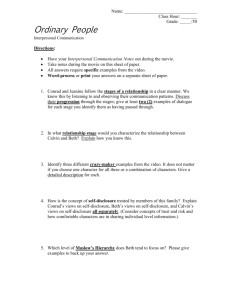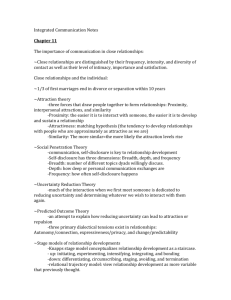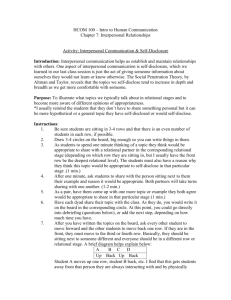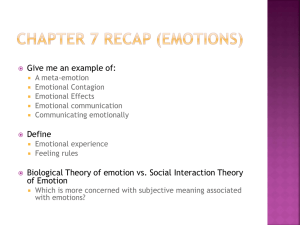Communication
advertisement
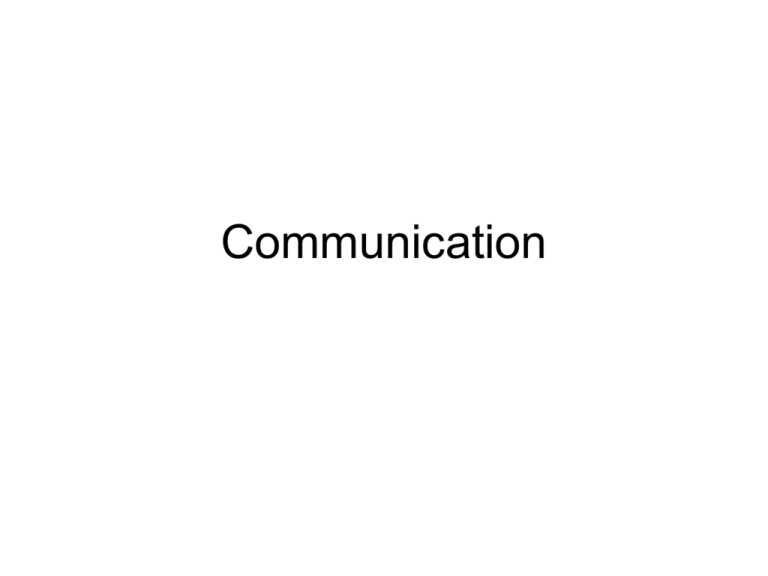
Communication Model of Interpersonal Communication Sender’s Intentions Sender’s Actions Effect on Listener Talk Table • Gottman, Notarius, Gonso, & Markman, 1976: Partners are asked to rate intended impact of message with buttons ranging from super negative to super positive. The partner then rates perception of message using the same buttons. • Unhappy couples don’t differ from happy couples in what they are trying to say, but in unhappy relationships partners perceive messages to be more critical and disrespectful Nonverbal Communication • Facial Expressions • Gazing Behavior – eye contact • Body language – gestures - posture • Touch • Interpersonal Distance – Intimate Zone – a foot and a half – Personal Zone – 1.5 ft to 4 ft – Social Zone – 4 – 12 ft • Paralanguage – Rhythm, pitch, loudness – how they say it Nonverbal Sensitivity • The sensitivity and accuracy with which couples communicate nonverbally predict how happy the relationship will be • When problems do occur, it’s often the husband’s fault. Husbands and Unhappy Marriages • Men in troubled marriages sent more confusing messages, and misinterpreted communications from their wives that were legible to strangers. And the husbands were clueless about the mistakes. • However, other studies have shown both partners in unhappy marriages have troubled communication Communication and Relationships 1. Nonverbal skills determine how satisfying relationships are. 2. Relationship satisfaction determines how hard people work to communicate. Verbal Communication: Self Disclosure • Self-disclosure – the process of revealing personal information to someone else. • Integral component in relationships. • Social Penetration Theory – development of relationship is tied to changes in communication – Changes in breadth – Changes in depth Breadth Increases faster than depth. Reciprocity and Self-Disclosure • Early communication between partners is characterized by reciprocity of selfdisclosure • Immediate reciprocity occurs less often as relationship progresses • Responsiveness becomes more important Self-Disclosure and Relationship Satisfaction • The more spouses self-disclose, the happier they tend to be. • Happy couples use idioms • Happy couples’ conversations are marked by obvious knowledge of the other person and relaxation • Self-disclosure is linked to happiness because… – We reveal things to people we like – Revealing things to people makes us like them more – We like to be entrusted with self-disclosures Privacy • Social penetration is rarely total, partners tend to value privacy too • A healthy balance between self-disclosure and privacy is ideal • The number one taboo topic is… Gender Differences in Verbal Communication: Topics of Conversation • Women talk about feelings and people. • Men talk about objects and actions. Styles of Conversation • Women speak with less forcefulness (e.g. “I am kind of interested” “It seems that way” • Women often make statements with rising inflection at end (e.g.I skipped class last Thursday?) • Women are less profane Self-Disclosure • Women are more self-disclosing • Men disclose more with women than with men • Wives express feelings – so if a husband doesn’t complain wives tend to interpret that is everything is ok • Men tend to interpret a lack of overt signs of affection as hostility Miscommunication • Kitchen sinking – drag several topics into converstion (e.g. it’s not just that you’re always late, it’s the fact you drink all the time and hang out with those friends and never clean up after yourself) • Off-beam – jumping from topic to topic • Negative-mindreading • Interrupt • Yes – butting • Cross - complaining The four horsemen of the apocalypse • Criticism, defensiveness, contempt, and withdrawal Good Communication • I-statements and XYZ statements vs. Youalways statements • Paraphrasing • Perception Checking • Avoid negative reciprocity • Validate (e.g.I don’t blame you for feeling that way, I understand that”
